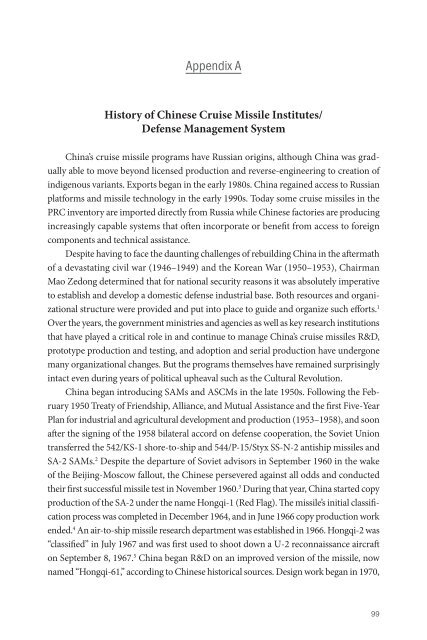Create successful ePaper yourself
Turn your PDF publications into a flip-book with our unique Google optimized e-Paper software.
Appendix A<br />
History of Chinese Cruise Missile Institutes/<br />
Defense Management System<br />
China’s cruise missile programs have Russian origins, although China was gradually<br />
able to move beyond licensed production and reverse-engineering to creation of<br />
indigenous variants. Exports began in the early 1980s. China regained access to Russian<br />
platforms and missile technology in the early 1990s. Today some cruise missiles in the<br />
PRC inventory are imported directly from Russia while Chinese factories are producing<br />
increasingly capable systems that often incorporate or benefit from access to foreign<br />
components and technical assistance.<br />
Despite having to face the daunting challenges of rebuilding China in the aftermath<br />
of a devastating civil war (1946–1949) and the Korean War (1950–1953), Chairman<br />
Mao Zedong determined that for national security reasons it was absolutely imperative<br />
to establish and develop a domestic defense industrial base. Both resources and organizational<br />
structure were provided and put into place to guide and organize such efforts. 1<br />
Over the years, the government ministries and agencies as well as key research institutions<br />
that have played a critical role in and continue to manage China’s cruise missiles R&D,<br />
prototype production and testing, and adoption and serial production have undergone<br />
many organizational changes. But the programs themselves have remained surprisingly<br />
intact even during years of political upheaval such as the Cultural Revolution.<br />
China began introducing SAMs and ASCMs in the late 1950s. Following the February<br />
1950 Treaty of Friendship, Alliance, and Mutual Assistance and the first Five-Year<br />
Plan for industrial and agricultural development and production (1953–1958), and soon<br />
after the signing of the 1958 bilateral accord on defense cooperation, the Soviet Union<br />
transferred the 542/KS-1 shore-to-ship and 544/P-15/Styx SS-N-2 antiship missiles and<br />
SA-2 SAMs. 2 Despite the departure of Soviet advisors in September 1960 in the wake<br />
of the Beijing-Moscow fallout, the Chinese persevered against all odds and conducted<br />
their first successful missile test in November 1960. 3 During that year, China started copy<br />
production of the SA-2 under the name Hongqi-1 (Red Flag). The missile’s initial classification<br />
process was completed in December 1964, and in June 1966 copy production work<br />
ended. 4 An air-to-ship missile research department was established in 1966. Hongqi-2 was<br />
“classified” in July 1967 and was first used to shoot down a U-2 reconnaissance aircraft<br />
on September 8, 1967. 5 China began R&D on an improved version of the missile, now<br />
named “Hongqi-61,” according to Chinese historical sources. Design work began in 1970,<br />
99


